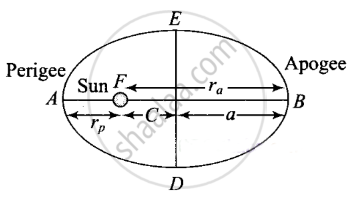Advertisements
Advertisements
प्रश्न
A satellite is in an elliptic orbit around the earth with aphelion of 6R and perihelion of 2 R where R= 6400 km is the radius of the earth. Find eccentricity of the orbit. Find the velocity of the satellite at apogee and perigee. What should be done if this satellite has to be transferred to a circular orbit of radius 6R ?
[G = 6.67 × 10–11 SI units and M = 6 × 1024 kg]
उत्तर
According to the diagram,
rp = radius of perigee = 2R
ra = radius of perigee = 6R
a = semi-major axis of the ellipse
Hence, we can write
`r_a = a(1 + e) = 6R`
`r_p = a(1 - e) = 2R`
`(a(1 + e))/(a(1 - e)) = (6R)/(2R)` = 3

By solving, we get eccentricity `e = 1/2`
If va and vp are the velocities of the satellite (of mass m) at aphelion and perihelion respectively, then by conservation of angular momentum
`L_("at perigee") = L_("at apogee")`
∴ `mv_pr_p = mv_ar_a`
∴ `v_a/v_p = r_p/r_a = 1/3`
Applying conservation of energy,
The energy at perigee = Energy at apogee
`1/2 mv_p^2 - (GMm)/r_p = 1/2 mv_a^2 - (GMm)/r_a`
Where M is the mass of the earth
∴ `v_p^2 (1 - 1/9) = - 2GM (1/r_a - 1/r_p)`
= `2GM(1/r_p - 1/r_a)` .....(By putting `v_a = v_p/3`)
`v_p = [2GM(1/r_p - 1/r_a)]^(1/2)/([1 - (v_a/v_p)^2]^(1/2)`
= `[((2GM)/R (1/2 - 1/6))/((1 - 1/9))]^(1/2)`
= `((2/3)/(8/9) (GM)/R)^(1/2)`
= `sqrt(3/4 (GM)/R)`
= 6.85 km/s
vp = 6.885 km/s, va = 2.28 km/s
For circular orbit of radius r,
vc = orbital velocity = `sqrt((GM)/r)`
For r = 6R, vc = `sqrt((GM)/(6R)` = 3.23 km/s.
APPEARS IN
संबंधित प्रश्न
Answer the following question.
State Kepler’s law of equal areas.
Observe the given figure and answer these following questions.

The orbit of a planet moving around the Sun
- What is the conclusion about the orbit of a planet?
- What is the relation between velocity of planet and distance from sun?
- Explain the relation between areas ASB, CSD and ESF.
State Kepler’s laws.
The mass and radius of earth is 'Me' and 'Re' respectively and that of moon is 'Mm' and 'Rm' respectively. The distance between the centre of the earth and that of moon is 'D'. The minimum speed required for a body (mass 'm') to project from a point midway between their centres to escape to infinity is ______.
The earth moves around the sun in an elliptical orbit as shown in the figure. The ratio, `"OA"/"OB"` = x. The ratio of the speed of the earth at Band at A is ______.

To verify Kepler's third law graphically four students plotted graphs. Student A plotted a graph of T (period of revolution of planets) versus r (average distance of planets from the sun) and found the plot is straight line with slope 1.85. Student B plotted a graph of T2 v/s r3 and found the plot is straight line with slope 1.39 and negative Y-intercept. Student C plotted graph of log T v/s log r and found the plot is straight line with slope 1.5. Student D plotted graph of log T v/s log r and found the plot is straight line with slope 0.67 and with negative X-intercept. The correct graph is of student
Supposing Newton’s law of gravitation for gravitation forces F1 and F2 between two masses m1 and m2 at positions r1 and r2 read F1 = – F2 = `- r_12/r_12^3 GM_0^2 ((m_1m_2)/M_0^2)^n` where M0 is a constant of dimension of mass r12 = r1 – r2 and n is a number. in such a case.
- the acceleration due to gravity on earth will be different for different objects.
- none of the three laws of Kepler will be valid.
- only the third law will become invalid.
- for n negative, an object lighter than water will sink in water.
Out of aphelion and perihelion, where is the speed of the earth more and why?
Two planets A and B of equal mass are having their period of revolutions TA and TB such that TA = 2TB. These planets are revolving in the circular orbits of radii rA and rB respectively. Which out of the following would be the correct relationship of their orbits?
Halley's Comet revolves around the sun for a time period of 76 years. The aphelion distance if perihelion is given by 8.9 × 1010 m, will be ______.
(Take, the mass of sun = 2 × 1030 kg and G = 6.67 × 10-11 Nm3/kg2)
